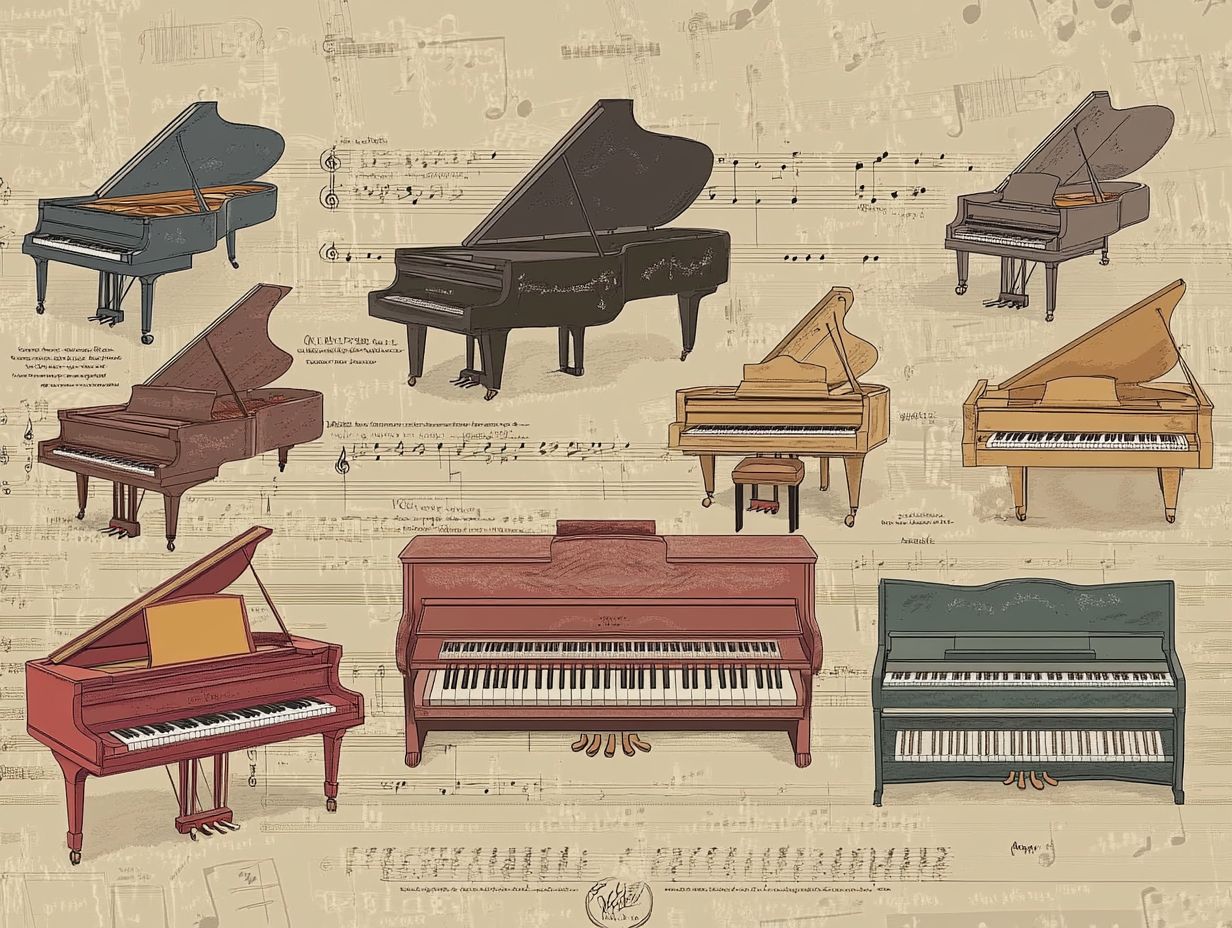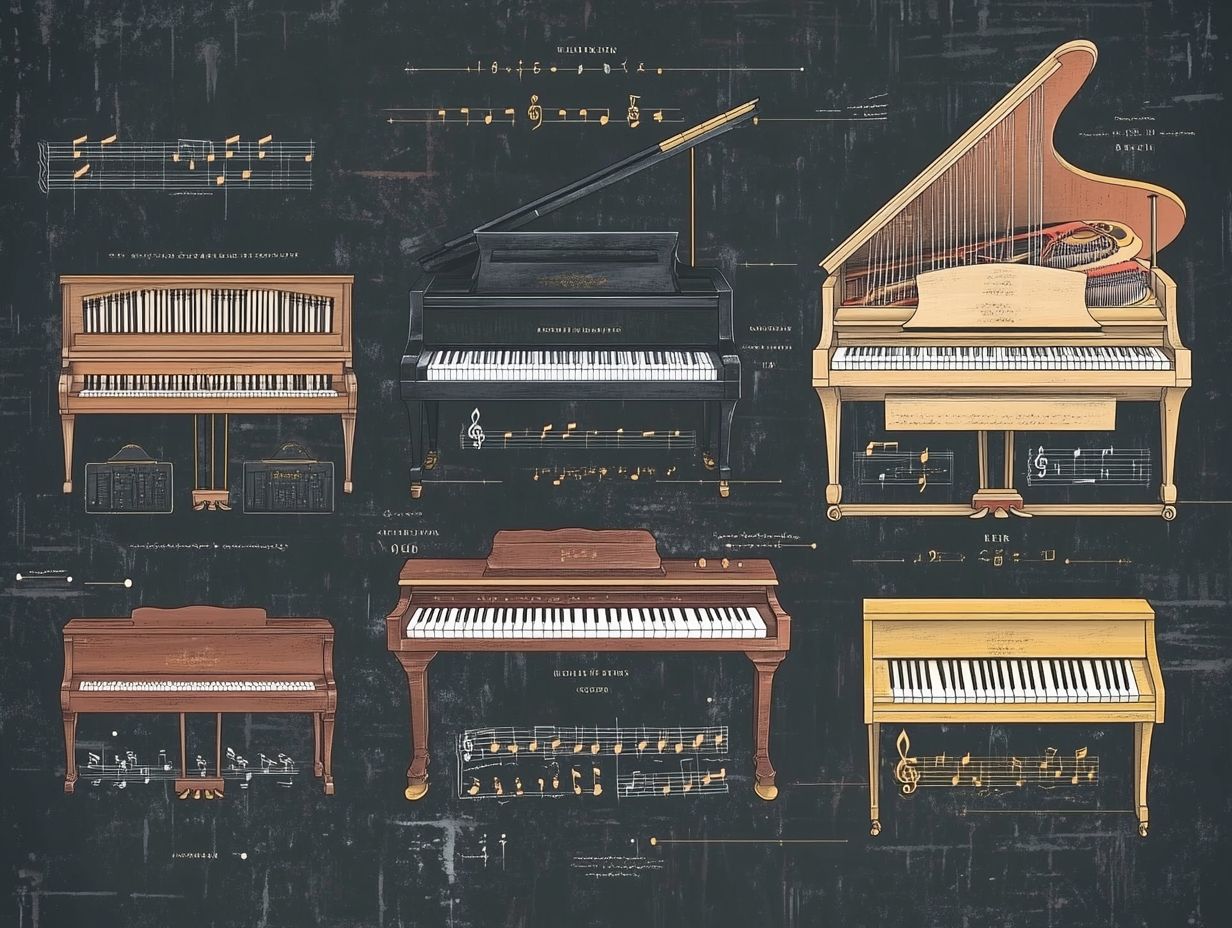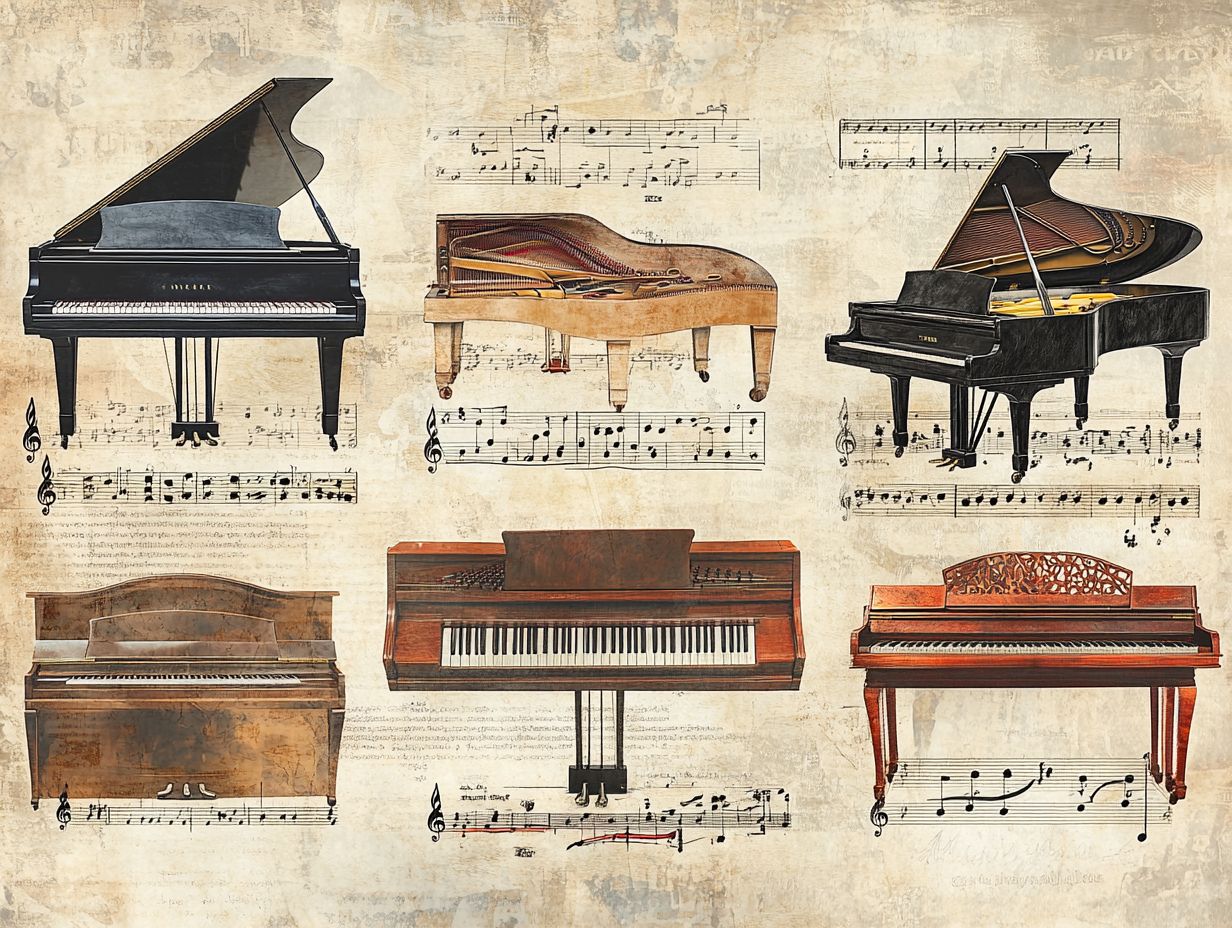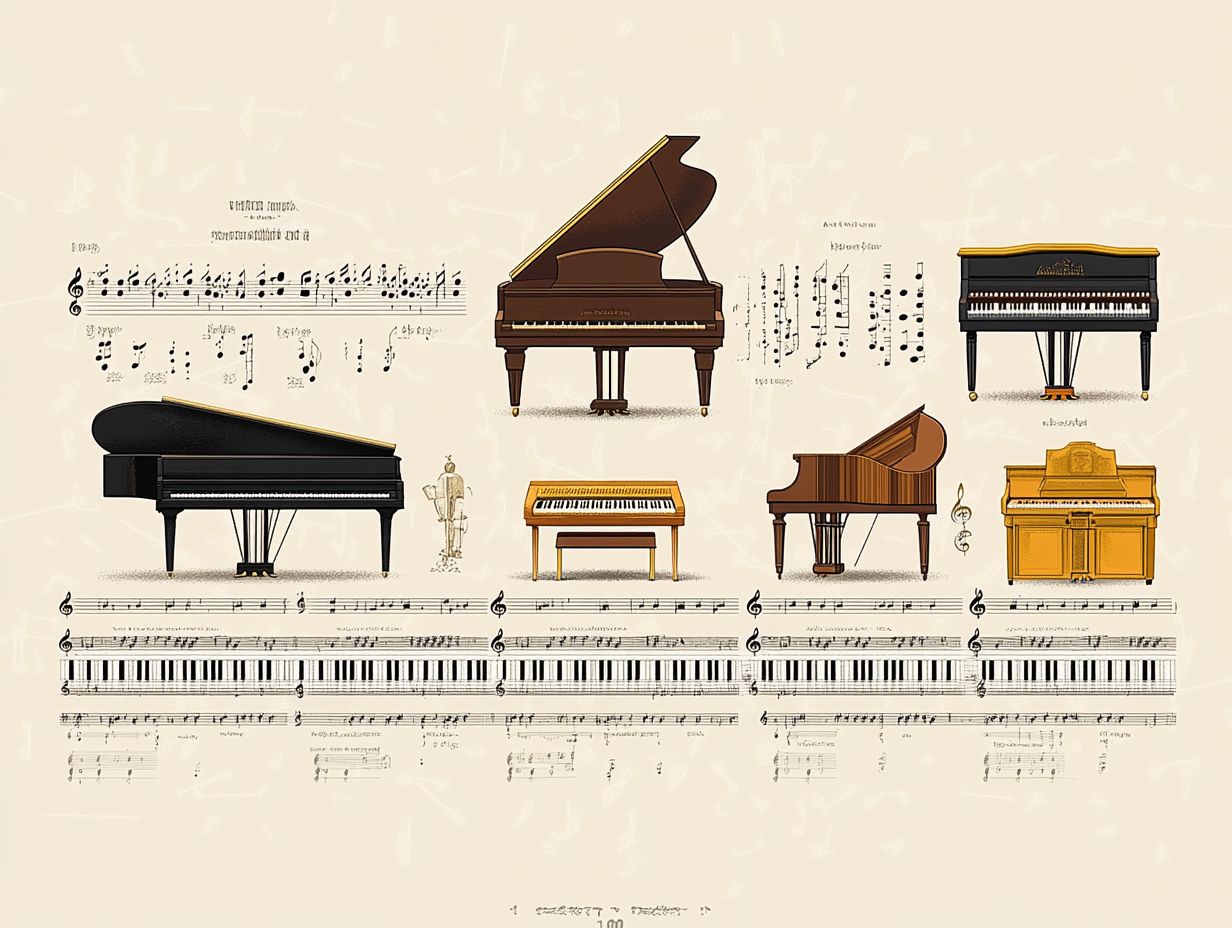The piano has an enchanting history that has evolved through centuries of musical innovation and cultural shifts.
This exploration traces its journey from the Classical Era, characterized by significant developments and influential composers, to the Romantic Era, where both design and techniques underwent dramatic transformations.
As we transition into the Modern Era, we discover how technological advancements led to the emergence of electric and digital pianos.
We also examine contemporary styles that blend influences from jazz, pop, and rock, while speculating on the future innovations that await this beloved instrument.
Join us in celebrating the remarkable evolution of the piano!
Contents
History and Origins of the Piano

The history and origins of the piano can be traced back to the early 18th century, showcasing a remarkable evolution from primitive keyboard instruments such as the harpsichord and clavichord to the modern pianos we know today, including grand pianos, upright pianos, and digital pianos. This journey encompasses significant innovations in piano construction, soundboard design, and the introduction of the action mechanism, which allows for dynamic expression. Cultural influences from various music genres, including classical and jazz, have played a pivotal role in shaping the piano’s repertoire and techniques.
The transition from the fortepiano to the contemporary piano marked a revolution in both sound and playability, primarily driven by the craftsmanship of influential builders such as Steinway and Bösendorfer in the 19th century. These advancements facilitated greater emotional depth and nuance in musical compositions, resulting in a rich body of piano literature from composers like Beethoven, Chopin, and Liszt.
As piano performance practices evolved, so too did music education, which increasingly emphasized technical proficiency alongside expressive playing. The rise of jazz in the early 20th century introduced improvisational techniques and new harmonies, broadening the piano’s role within diverse musical contexts and ensuring its enduring significance across generations.
The Classical Era: Development and Characteristics
The Classical Era is a pivotal period in music history, characterized by renowned composers such as Mozart and Haydn. These musicians harnessed the evolving capabilities of the piano to develop intricate performance techniques and music theory principles that remain relevant today.
The evolution of the piano during this time introduced new techniques that emphasized clarity, balance, and expression, resulting in a rich repertoire that would come to define classical music.
Key Innovations and Influential Composers

Key innovations during the Classical Era, such as improvements in piano construction and the introduction of the una corda pedal, paved the way for composers like Beethoven and Chopin to explore new expressive possibilities and dynamics in their music. These advancements forever altered the piano repertoire and the landscape of performances.
Virtuoso composers pushed the boundaries of musical expression by employing advanced techniques that captivated audiences. The evolution of the piano, particularly the transition from the harpsichord to the fortepiano, enabled a greater dynamic range and tonal color.
This shift not only inspired composers to create more intricate and emotive pieces but also encouraged performers to experiment with diverse interpretative styles. As the action of the piano became more responsive, musicians were able to achieve a level of nuance that was previously unimaginable.
These innovations led to the rise of technically demanding works, showcasing the brilliance of performers who could navigate the new challenges presented to them, thereby elevating the importance of virtuosic playing in capturing the spirit of the era.
The Romantic Era: Changes and Impact
The Romantic Era introduced significant changes in piano music, emphasizing emotional expression and individualism while embracing new musical styles that diverged from the formal structures of the Classical Era.
Composers like Liszt and Schumann expanded the possibilities of piano performance by utilizing innovative techniques and a more nuanced harmonic language.
As a result, the piano evolved into a more expressive instrument, capable of conveying personal emotions and intricate narratives.
Evolution of Piano Design and Playing Techniques

The evolution of piano design during the Romantic Era was marked by intricate craftsmanship and technological advancements, resulting in the development of more powerful soundboards and the introduction of diverse playing techniques that emphasized timbre and dynamics.
Historical pianos featured unique designs tailored to meet the expressive demands of the time, significantly influencing how musicians approached piano playing. Artisans meticulously crafted these instruments, utilizing innovations such as improved action mechanisms and high-quality materials, which enhanced both responsiveness and tonal quality.
This attention to detail allowed performers to explore new expressive possibilities, ranging from gentle whispers to thunderous crescendos. The incorporation of features like the una corda pedal facilitated a delicate touch, transforming the performance landscape and enabling players to convey a broader spectrum of emotions.
This intricate interplay between design and artistry not only redefined the musical experience but also established the piano as a central instrument in the evolution of Western music.
The Modern Era: Technological Advancements
The Modern Era has introduced transformative technological advancements to the piano, including the development of digital pianos and MIDI technology, which have revolutionized music production and composition.
These innovations enable musicians to explore new creative possibilities by blending traditional piano techniques with contemporary electronic music styles, thereby enhancing the instrument’s versatility across various musical genres.
Electric and Digital Pianos

Electric and digital pianos are among the most popular alternative instruments to acoustic pianos, and they have gained significant popularity as replacements. These instruments offer sound design features and practice methods that seamlessly blend traditional and modern techniques, making piano playing more accessible to a broader audience.
Their user-friendly interfaces and a wide variety of instrument sounds enable musicians to express diverse musical styles, from jazz to pop and beyond. Additionally, the capability to connect with software applications and educational programs allows students to explore their creativity in real-time.
The inclusion of headphone outputs enables private practice without disturbing others. Acquiring these skills is essential for musical growth, and electric and digital pianos provide musicians with cutting-edge tools to enhance their abilities through rapidly advancing technology.
Contemporary Piano Styles and Techniques
Contemporary piano styles encompass those associated with jazz piano, pop music, improvisation, and various other techniques that illustrate the modern evolution of the instrument.
Incorporation of Jazz, Pop, and Rock Music
The incorporation of jazz, pop, and rock music into piano playing has significantly expanded the instrument’s repertoire and appeal, challenging traditional notions of classical music while introducing improvisational skills as a vital aspect of contemporary performance. This blending of genres allows for greater artistic expression and creativity.
By embracing these diverse styles, pianists can explore a wide array of playing techniques, from the syncopated rhythms commonly found in jazz to the catchy hooks typical of pop, as well as the robust energy characteristic of rock. Such influences transform the approach to performance, encouraging musicians to experiment with chords and scales, thereby enhancing their improvisational abilities.
This fusion not only broadens the scope of musical expression but also encourages performers to engage more deeply with their audience, bridging the gap between performer and listener through relatable and dynamic interpretations. As a result, piano music evolves into a vibrant mosaic of influences that celebrates both tradition and innovation.
The Future of the Piano
The future of the piano is anticipated to reflect a harmonious blend of innovation and tradition. Ongoing advancements in technology, teaching methods, and performance practices are set to shape how the instrument is used and perceived in music education and composition.
Emerging trends include a greater integration of digital synthesis and cross-genre influences.
Possible Innovations and Trends
Possible innovations and trends in piano technology include the evolution of sound, interactive learning platforms, and enhancements in digital synthesis that cater to the artistic needs of modern musicians. These developments are set to transform how pianos are constructed, played, and integrated into contemporary musical styles.
The introduction of smart pianos equipped with artificial intelligence could provide personalized learning experiences by offering real-time feedback and tailored lessons based on the player’s current skill level. Hybrid pianos, which combine acoustic and digital components, may open new aesthetic avenues for performers while preserving traditional craftsmanship.
Additionally, augmented reality applications could create more immersive practice sessions, allowing students to engage in visually stimulating environments that enhance their understanding of music theory and composition.
As these innovations emerge, they will not only enrich musical expression but also inspire a new generation of artists and educators, ensuring that piano playing continues to evolve in exciting and meaningful ways.
